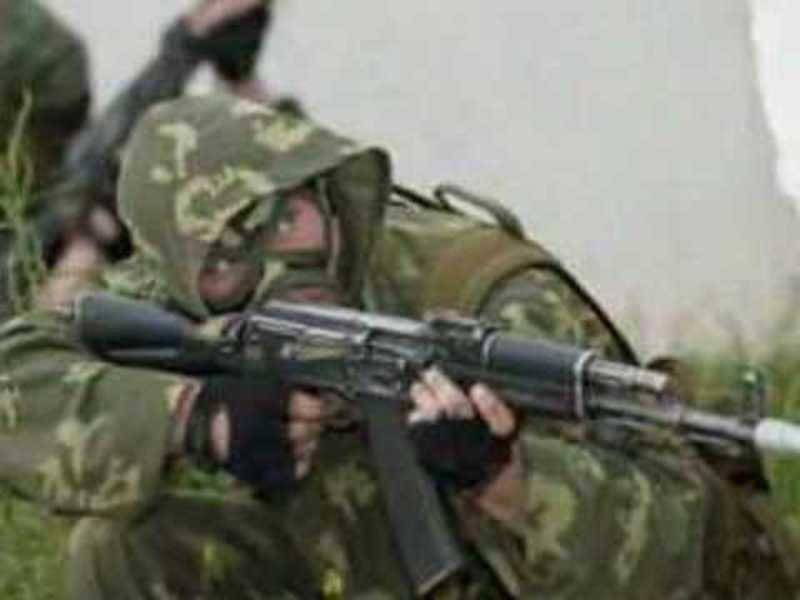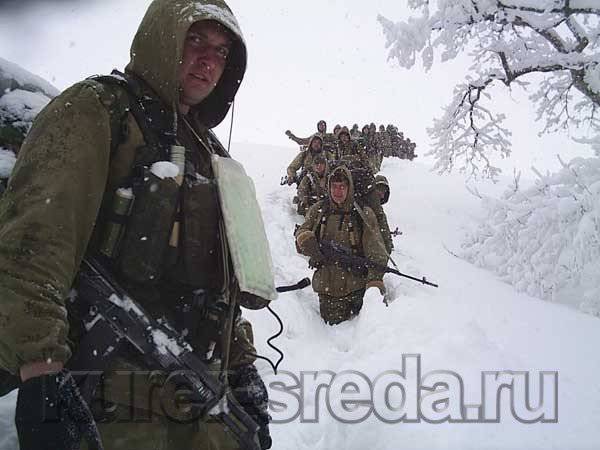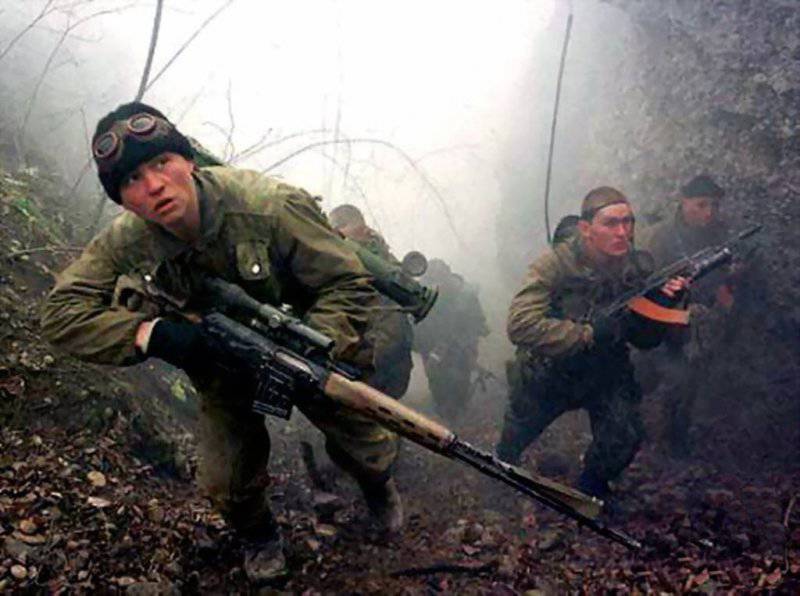GRU spetsnaz is the elite of the Russian troops: from birth to ...
After 1945, the reconnaissance and sabotage units in the army, in essence, did not remain, because some of them were reduced and attached to other military formations, and some were disbanded. But very quickly they realized that special forces groups are the most effective way to combat the impending nuclear threat from NATO. Therefore, after careful study and generalization of the experience accumulated during the war in 1950, it was decided to create the first special forces units in the Soviet Union. As of the beginning of May 1951, the 46 company was created, each of which had 120 people. All of them were subordinate to the Main Intelligence Directorate of the General Staff of the Army.
Excursion in history Russian special forces
Those who think that the idea of creating special task forces is a matter of the recent past is mistaken. Formations with similar objectives emerged in Russia for a long time.
• Russian commanders Peter Panin, Alexander Suvorov and Mikhail Kutuzov already in the XNUMXth century raised the issue of creating special military units.
• They originated in 1764 and were called jaegers.
• At the end of the XNUMXth century, Catherine II initiated the rotation of the Zaporizhzhya Cossacks to the Bug and then to the Kuban, where the tactics of the "jaegers" came in handy - military operations in the highlands, ambushes, reconnaissance, raids.
• The motto of the units is “Fox tail, wolf mouth”, and the training was reminiscent of modern warfare, a combination of undercover and power intelligence.
• In 1797, Emperor Paul I introduced a new Charter, developed in the likeness of the charter of the Prussian army.
• 1811 was marked by the creation of OKVS - a separate corps of internal guards, which was engaged in the protection or restoration of order within the state.
• Alexander I took care of the creation of mobile cavalry rapid response gendarmes in 1817.
• In the war of 1812, the Russian army gained tremendous experience, which was widely used later.
• In 1826, the influence of the Imperial Chancellery increased.
• 1842 battalions of scouts are created from Cossack battalions, on whose subsequent combat activities many generations of the future special forces were trained.
• In 1903, the Intelligence Department of the General Staff was created. A year later - in all military districts.
• In 1905, the influence of the tsarist Okhrana was growing, and formations were created on the basis of the police, the goals and objectives of which resemble the mission of today's OMON.
• In 1917, the Bolsheviks created the People's Commissariat for Military Affairs - the Main Directorate of the General Staff - GUGSH.
• In 1918, military intelligence was created. In the same year, CHONs were created - special-purpose units subordinate to the Cheka - to fight all kinds of rebels and Asian Basmachi.
• In the 30s, an airborne assault force and sabotage units were created in the Red Army.
Milestones of history
The tasks before the new formation were serious: organizing and conducting reconnaissance, destroying any means of nuclear attack, identifying troop formations and conducting special missions in the enemy rear, organizing and conducting sabotage actions, creating rebel (guerrilla) detachments behind the enemy, fighting terrorism, searching and neutralization of saboteurs. Among other tasks - interfering with the work of communication, disruption of power supply, liquidation of transport hubs, induction of chaos in the military and state administration of the country. Most of the tasks sound, at least, fantastic, but the GRU special forces could easily cope with them: they had at their disposal the appropriate technical equipment and weapons, including portable nuclear mines.
The training of special forces was characterized by high intensity and was carried out using individual programs. Each 3-4 soldier was assigned an 1 officer who watched his pupils day and night. And the officers themselves were trained according to such a rich program that, after several years of training, each of them could independently replace the whole military unit.
Needless to say, the special forces were classified more than the nuclear development of the USSR. At least, everyone knew about the presence of nuclear missiles, nuclear warhead bombers and nuclear submarines, and not every marshal and general knew about the GRU special forces.
Also one of the tasks of the special forces was the elimination of prominent figures of the enemy countries, but then this task was canceled. (If not coded even deeper).
The first manual for the special forces - “Instructions for the combat use of units and divisions of special purpose” was written by Pavel Golitsin - the former intelligence chief of the Belarusian partisan brigade “Chekist”.
But not everything was so good. Already in 1953, the Armed Forces began to cut and 35 mouth cut. There are only eleven special companies of special purpose (ORSPN). For four whole years, it was necessary for the army special forces to improve their shaky positions after such a strike, and only in 1957 did the 5 special purpose battalions be created, which in 1962 were joined by special forces brigades along with the remnants of the old companies. They were designed for peacetime and wartime. According to the peacetime states, there were no more 10-200 fighters in the brigade; in the military, there were no less than 300 soldiers and officers in ObrSpNb. By the beginning of the 1700, the USSR special forces included: 1963 cropped brigades, 10 individual battalions, 5 separate companies in the Leningrad, Baltic, Belarusian, Prikarpatsky, Kiev, Odessa, Transcaucasian, Moscow, Turkestan, Far Eastern military districts.
In the same year, the GRU conducted the first large maneuvers, but, despite the excellent results of training the fighters, the special forces lost the 1964 battalions and 3 companies already in 6, and the 6 mouth, 2 battalions and 10 brigades remained in the army special forces. Separately, it should be said about the units that, in addition to the standard training of the special forces, trained for special tasks. Thus, the 99 fighters of the company that stationed in the Arkhangelsk military district focused on operations in the cold of the Arctic, and the soldiers of the 227 special forces located in the North Caucasus Military District were trained to survive in the highlands. Further intensification of work on the creation of special forces strike groups began only at the end of the 60-s.
Staff training
In 1968, on the basis of the Ryazan Airborne School began to prepare professional intelligence special forces. It was then that the legendary 9 Company appeared. The 9 Company rotated its latest issue in the 1981 year, then it was disbanded. Special Forces officers were also trained at the Frunze Military Academy and at the intelligence department of the Kiev VOK, but by their specialization they were more likely military reconnaissance. In 1970, a training company was formed, then a battalion, and then a regiment stationed in the Pskov Region.

When in 1985 (after 6 years after the start of the war!) It became clear that soldiers needed special training in front of Afghanistan, a training regiment was created in the Uzbek Chirchik.
Operations abroad
The first major foreign special operations operation took place in the 1968 year, after which he no longer had to prove his worth. It was in that year that the countries united by the Warsaw Pact introduced their troops into Czechoslovakia. To begin with, our plane requested an emergency landing from the capital of the country due to engine failure. Within a few minutes, our special forces seized the airport, to which very soon the airborne division was deployed. At this time, previously arrived in Prague units took control of the “railway stations, newspapers and telegraph,” that is, all key positions. After the seizure of the government building, the special forces took the country's leadership to Moscow.
In total, the army special forces sent their troops to two dozen countries in Asia, Latin America and Africa. They had to deal with the American commando. Only many years later, the Americans learned who really defeated their elite units in 1970, in Vietnamese Sean Thay, in 1978, in Angola. Often their special services did not even know about the operations carried out by our fighters. Here is a vivid illustration.
In 1968, the 9 of our fighters made a classic raid on a top-secret helicopter camp in Cambodia, located in 30 kilometers from the Vietnamese border. The US military threw their reconnaissance and sabotage groups out of it to Vietnam, and from there they flew out in search of their downed pilots. The camp was guarded by 2 light helicopters, 8-10 heavy transport and 4 Super Cobra helicopters. The new modification of the "turntable" fire support with the presence on board guided missiles and the latest guidance systems at the target and was the goal of our paratroopers. Only 25 minutes ponabilos our special forces, to hijack one and destroy the three remaining helicopters under the nose of American commandos.
Afghan company
On the combat operations of the Soviet special forces in the territory of Angola, Mozambique, Ethiopia, Nicaragua, Cuba and Vietnam there is still very little free information.
There is much more data on the ten-year Afghan war. It began with a complex special operation to eliminate the ruler of Hafizul Amin. Until now, historians consider the capture of the Amin fortress and its destruction a pure gamble, nevertheless, it was a success. In addition to the KGB special forces "Thunder" and "Zenith" existing at that time, the future "Alpha" and "Vympel", special forces of the GRU took part in the operation. About six months before the landmark assault, a Muslim battalion, the so-called "Musbat" or the 154th separate special forces detachment, was created, which included GRU soldiers from among Soviet Muslims. It was staffed by Tajiks, Uzbeks and Turkmens who served in tank and motorized rifle units. Most of them owned Farsi. Shortly before the assault, this detachment was secretly introduced into the palace guard. The assault itself lasted only 40 minutes. 7 special forces soldiers were killed in the palace. This unit, not counting a short respite after this operation, until 1984 conducted combat operations on special forces tactics, staged raids and ambushes, and carried out reconnaissance in Afghanistan.
At the end of 1983, the army team began to create the “Veil” border zone, along the entire length of Jalalabad - Ghazni - Kandahar. With its help, it was planned to block two hundred caravan routes, which the rebels delivered ammunition and weapon from Pakistan. But for such a grand plan, there was a lack of special forces in Afghanistan, so in 1984, the 177 squad of a special purpose was deployed here, followed by the 154 squad. Total personnel of the special forces of the GRU GS in Afghanistan was about 1400 people. Since this also seemed not enough, the formation of additional special-purpose military formations began in the USSR.
Among the memorable operations can be called many. For example, in January 1984, company 177, reinforced by a tank platoon and two companies of the Afghan army, was supposed to find and capture a caravan in the area of the Vakh village, where, according to information, weapons and ammunition of dushmans were supposed to arrive. However, the enemy was not detected, and after lunch our detachment was surrounded. And after a hard fight, gaining support aviation and artillery detachment left the danger zone.
In 1989, the structure of the 15 and 22 SPN brigades was fundamentally changed. Armored military equipment, grenade launchers, communications controls, including space ones, were withdrawn from brigades as inappropriate to their tasks - that is, conducted anti-sabotage wrestling and military intelligence. The 10-summer standoff of the special forces adversary was recognized as an “atypical case of use” ...
However, in the 1990 year, when the 15 brigade arrived in Baku to fight the gangs of the country's Popular Front, the equipment was returned to them. Then the special forces made 37 flights with IL-76 BTA planes and delivered more 20 units of armored combat vehicles, vehicles, and communications equipment from Tashkent. The presence of soldiers and officers who knew not so much about the fight against saboteurs allowed the brigade, at that time under the office of the KGB of the USSR, to perform all the tasks assigned. And when he returned home, despite numerous requests from the command of the unit, all military equipment and communications equipment was simply withdrawn.
Chechen company
In the first Chechen 1994-1996. Russian special forces were present in Chechnya from the moment the troops entered by separate and joint detachments. At first it was used only in intelligence. Because of the weak preparation of the ground forces, special forces soldiers took part in assault groups, as happened in Grozny. 1995 year brought very high losses in the special forces - this year's battles the most tragic in the whole history of the special forces of Russia and the USSR.
But despite everything, the special forces began to work on their traditional tactics, especially standing out in ambush actions. After the signing of the Khasavyurt Agreement, after which the North Caucasus temporarily entered a period of shaky peace, it was clear that the conflict had not yet been settled. Therefore, with the beginning of the battles in Dagestan in confrontations with armed militias, international and Chechen terrorists, the task of the special forces was to provide reconnaissance troops with respect to fortifications and Wahhabi positions. I had to fight with "old friends" on an Afghan company from among Arab, Pakistani and Turkish mercenaries and instructors. Ours could recognize many of them by their inherent features of mining, avoiding pursuit, radio exchange, and choosing places for ambushes. The spetsnaz of the GRU was in the first place among the other units in combat training and the execution of assigned tasks, acting 10 times more efficiently than the others.
Separate and consolidated detachments were from the brigades of the Siberian, Moscow, Ural, Trans-Baikal, Far Eastern, and North Caucasian military districts.

In the spring of 1995, there were no detachments left in Chechnya, the latter, a separate special forces unit assigned to the North Caucasus Military District, returned to Russia in the autumn of 1996.
Troubled times
The years following the collapse of the Soviet Union were the most difficult for the army in general and special forces in particular. In a series of reforms and reorganizations, special forces suffered such damage that it did not suffer even during the wars in Afghanistan and Chechnya. After the war in Afghanistan, some brigades returned to their former locations, some - disbanded. Periodically, units of the brigades were thrown into places of armed clashes with various illegal formations. Thus, the 173 squad participated in the elimination of unrest in Baku and Ossetia, when intervention in the Ossetian-Ingush conflict was necessary, and fought on the territory of Nagorno-Karabakh. The detachments of the GRU of Moscow IN supported the constitutional order in Tajikistan. Fighters of the 12 th brigade of the special forces of the Transcaucasian Military District fought in Tbilisi and Azerbaijan, and then, from 1991, in Nagorno-Karabakh and North Ossetia. The 4 Brigade (Estonia) was disbanded in the 1992 year; before that, the Special Brigade was withdrawn from the Soviet Group of Forces of Germany. The Pechersk training special forces regiment was also disbanded.
After the collapse of the Union, the 8-I, 9-I and 10-I special-purpose brigades became part of the Armed Forces of Ukraine, where the 8-i was reorganized and turned into the 1-th paratrooper regiment, the other two were disbanded. Belarus got the 5-I Special Forces Brigade, Uzbekistan - the 15-I Specialty Brigade, the 459-I Specialty Company, one training regiment.
So how many units of GRU special forces today?
To clarify until the end of this question can not be. Partly because of the secrecy of information, partly because of the constant reform of the Armed Forces of the Russian Federation - in other words, reductions. But if you analyze the available information, you can calculate that today there are at least 9 special forces brigades and two battalions, "West" and "East." There are a number of military formations, the fighters of which are identical to the one that was in the special forces. Although it’s not a fact that these units are part of the GRU system - they may well be in the 45 department of the separate reconnaissance regiment of the Airborne Forces, individual reconnaissance units, the Navy, GUIN, the Ministry of Emergency Situations, the Ministry of Internal Affairs or the FSB structures.

Information